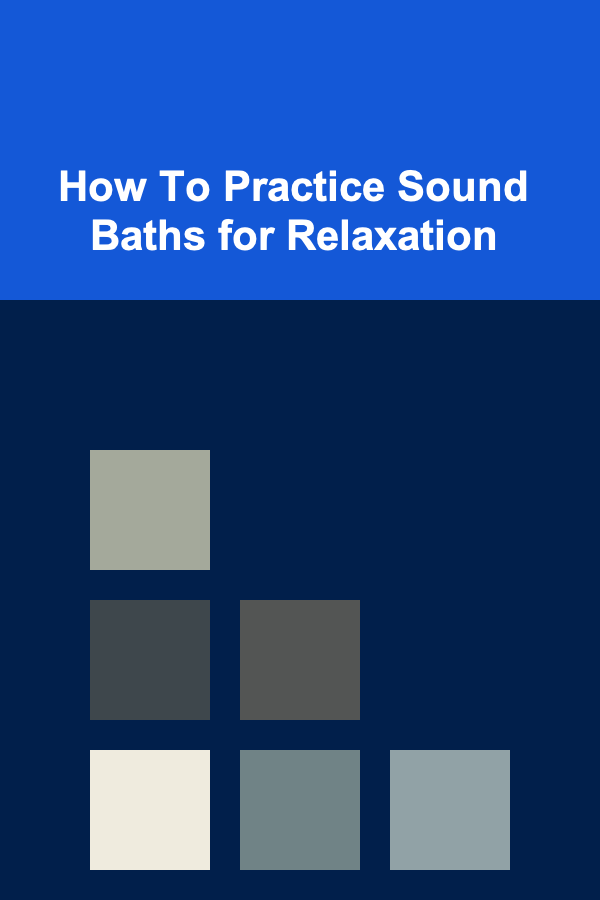
How To Practice Sound Baths for Relaxation
ebook include PDF & Audio bundle (Micro Guide)
$12.99$10.99
Limited Time Offer! Order within the next:

In a world where stress, anxiety, and overwhelming daily demands seem to take center stage, people are increasingly seeking alternative methods to rejuvenate and restore their mental and emotional balance. One such practice that has gained significant attention is the sound bath. Rooted in ancient traditions and gaining popularity in the modern wellness world, sound baths have proven to be an effective way to promote deep relaxation, mindfulness, and even physical healing. This article will explore the practice of sound baths, its historical and scientific background, how to prepare for and conduct a sound bath session, and the benefits it offers.
What Is a Sound Bath?
A sound bath is a therapeutic practice in which participants are immersed in sound waves produced by various instruments. These sounds are intended to relax the mind, release emotional tension, and promote a deep state of meditation and healing. Unlike a traditional music listening experience, a sound bath isn't just about hearing the sounds; it's about feeling them and letting them wash over your body and mind.
The instruments used in sound baths typically include Tibetan singing bowls, crystal bowls, gongs, chimes, drums, tuning forks, and other vibrational tools that emit different frequencies and tones. These instruments are believed to have a powerful impact on the mind and body due to their ability to resonate at specific frequencies.
The Origins of Sound Baths
The concept of sound therapy has existed for thousands of years across various cultures. Ancient civilizations such as the Egyptians, Greeks, and Chinese believed in the healing power of sound. For example, the ancient Greeks used music in healing rituals, while Egyptians were known to use sound to create an environment of spiritual and emotional healing.
In the modern world, the practice of sound baths has roots in the early 20th century. Pioneers like Dr. Hans Jenny, a Swiss scientist, began exploring the relationship between sound vibrations and the physical world. His experiments led to the discovery of how sound frequencies could create patterns in matter, a phenomenon known as "Cymatics."
The modern-day sound bath movement draws on these historical roots and the work of sound healers who use sound waves as a tool to promote physical and emotional well-being. It gained significant traction in the 1970s and has continued to evolve into the popular practice it is today, especially in wellness circles.
The Science Behind Sound Baths
To understand why sound baths can be so effective, it's important to explore the science behind sound and its impact on the human body.
Brainwave Frequencies
The human brain operates at different frequencies depending on the activity in which it is engaged. These frequencies are measured in Hertz (Hz) and can be classified into various states:
- Delta Waves (0.5-4 Hz): Associated with deep sleep and restorative states.
- Theta Waves (4-8 Hz): Linked to deep relaxation, meditation, and creativity.
- Alpha Waves (8-12 Hz): Present during light relaxation, like daydreaming.
- Beta Waves (12-30 Hz): Present during active thinking, problem-solving, and alertness.
- Gamma Waves (30-100 Hz): Associated with high levels of mental activity and focus.
Certain frequencies produced in a sound bath can trigger brainwave states associated with deep relaxation and healing. For example, the low vibrations from gongs or Tibetan singing bowls can promote the production of Theta waves, helping the listener reach a deeply meditative state. The sounds can slow the brain activity, enabling the listener to enter a relaxed state of consciousness that is not easily achieved through traditional meditation techniques.
The Vagus Nerve and Sound Frequencies
The vagus nerve is the longest nerve in the human body and is part of the parasympathetic nervous system, which governs the body's relaxation responses. Sound frequencies, particularly those with lower tones, have been shown to stimulate the vagus nerve, triggering a relaxation response. By activating this nerve, sound baths can help reduce heart rate, lower blood pressure, and release stress hormones, making it an excellent tool for stress relief.
Resonance and the Body
Our bodies are made up of water, which makes us particularly responsive to sound vibrations. Just as tuning forks resonate with certain frequencies, different parts of the body also resonate with specific tones. For example, the heart resonates with certain low-frequency sounds, while the head may respond more to higher frequencies. The idea is that by exposing the body to these healing frequencies, you can promote physical and emotional harmony.
How to Practice Sound Baths for Relaxation
Now that we have an understanding of the science and theory behind sound baths, let's dive into how to actually practice a sound bath for relaxation. Whether you are experiencing a sound bath at a group session or practicing on your own at home, there are key steps to follow for an optimal experience.
1. Find a Quiet Space
The first step to creating an effective sound bath experience is ensuring that you are in a peaceful, quiet environment. Sound baths require concentration and presence, so a tranquil space free from distractions is essential. This could be a designated meditation room, your bedroom, or even a quiet corner of a park. If you're doing this at home, consider dimming the lights, and removing distractions such as phones and electronic devices.
2. Prepare Your Mind and Body
Before beginning a sound bath, it's important to prepare your body and mind for the experience. Begin by sitting or lying in a comfortable position, with your spine straight and your body relaxed. Take a few deep breaths, inhaling deeply through your nose and exhaling slowly through your mouth. This helps to center your mind and begin the process of relaxation.
If you're practicing at home, you may wish to incorporate aromatherapy or soft lighting (such as candles) to create an immersive sensory experience. Some people also find that light stretching or gentle yoga before a sound bath helps to loosen up any tension in the body.
3. Set Your Intentions
Sound baths can be more effective if you set a specific intention or goal for the session. Are you looking to release stress? Do you want to focus on healing a specific emotional wound? Or perhaps you're seeking clarity or creativity? Setting an intention helps to channel the energy of the sound bath towards your personal goals and can make the experience more profound.
4. Let the Sound Wash Over You
Once you're ready, the sound bath begins. If you're in a group setting, the sound healer will play various instruments such as gongs, Tibetan singing bowls, or crystal bowls. The sound will shift in tone and intensity throughout the session, allowing you to feel the vibrations reverberate throughout your body. Try not to focus too much on the sound itself or the thoughts in your mind. Instead, let the vibrations permeate your being and guide you into a state of deep relaxation.
If you're practicing on your own, there are many online resources, including sound bath recordings, that you can use. Choose sounds that resonate with you, whether it's a gong sound or the soothing tones of a singing bowl.
5. Focus on Your Breath
As the sound waves wash over you, pay attention to your breath. Inhale deeply and exhale slowly, allowing the breath to flow naturally. If your mind begins to wander, gently bring your focus back to the breath or the sound. The combination of sound and breath helps to deepen the relaxation process, bringing you closer to a meditative state.
6. Stay in the Moment
Throughout the sound bath, try to stay present and avoid analyzing or judging the experience. It's easy for the mind to wander, but the key is to allow the sounds and vibrations to do their work. Trust that the sound is affecting your body and mind on a deeper level, even if you can't consciously understand how.
7. Slowly Transition Back
As the session draws to a close, the sounds will begin to fade. When the sound bath is over, avoid jumping up too quickly. Give yourself a few moments to slowly transition back into the present moment. You may wish to meditate for a few minutes, stretch gently, or journal about your experience.
8. Integrate the Experience
After a sound bath, many people feel relaxed, grounded, and more at peace. To make the most of this relaxation, it's important to integrate the experience into your daily life. Consider journaling, practicing mindfulness, or engaging in other relaxation techniques to carry the sense of calm with you throughout your day.
The Benefits of Sound Baths
Sound baths offer a wide range of benefits for the mind, body, and spirit. These include:
1. Stress Reduction and Deep Relaxation
Sound baths are one of the most effective ways to reduce stress and promote relaxation. The sound vibrations help to quiet the mind, reduce anxiety, and activate the parasympathetic nervous system, which is responsible for the body's relaxation response.
2. Improved Sleep
The deep relaxation induced by sound baths can help people suffering from insomnia or poor sleep. By promoting a state of calm and reducing the body's fight-or-flight response, sound baths can make it easier to fall asleep and stay asleep.
3. Enhanced Emotional Healing
Sound baths have been shown to help individuals process and release suppressed emotions. The vibrations from the sound help to shift energy in the body, which can lead to emotional healing, greater self-awareness, and clarity.
4. Pain Relief and Physical Healing
Sound therapy has been used to reduce physical pain, alleviate tension in the body, and promote healing. The vibrations from the instruments can help release blockages in the body and stimulate the healing process.
5. Increased Creativity and Focus
Many people report heightened creativity and clarity of thought after a sound bath. By calming the mind and reducing mental clutter, sound baths can help improve focus and foster a creative mindset.
Conclusion
Sound baths are a powerful tool for relaxation, healing, and emotional growth. Through the use of sound and vibrations, they offer an opportunity to reconnect with yourself, release tension, and experience deep peace. Whether practiced in a group setting or at home, sound baths can provide a transformative experience that enhances both physical and mental well-being. By following the steps outlined above and integrating sound baths into your routine, you can begin to harness the healing power of sound to live a more balanced and fulfilled life.

Building Strong Relationships: Customer Service Excellence in Technical Support
Read More
How to Invest in High-Yield Savings Accounts for Safe Growth
Read More
How to Keep Your Pet's Skin and Coat Healthy at Home
Read More
How to Set Up a Sleepover Kit for Friends
Read More
How to Use Labels for Organizing Garage Tools
Read More
10 Tips for Planning a Romantic Date Night at Home
Read MoreOther Products

Building Strong Relationships: Customer Service Excellence in Technical Support
Read More
How to Invest in High-Yield Savings Accounts for Safe Growth
Read More
How to Keep Your Pet's Skin and Coat Healthy at Home
Read More
How to Set Up a Sleepover Kit for Friends
Read More
How to Use Labels for Organizing Garage Tools
Read More